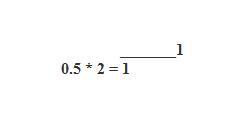Represent the number (-26.5)10 as a floating point binary number with 24 bits. The normalized fraction mantissa has 16 bits and the exponent has 8 bits. Make and state suitable assumptions, if any 5m Dec2005
First of all draw the 24 bits precision representations
S stands for Sign (white color)
E stands for Exponent (yellow color)
N stands for Number (also called Mantissa or Significand) (green color)
Then to represent we have (-26.5)10 using 24 bits precision representations
Since number is a negative number
Sign bit is: 1
| 1 |
Now let’s work on Mantissa part
Convert 26 into binary form i.e 11010
Remaining is fraction part 0.5
Now we multiply fraction value with 2 till we get whole number 1 at the end.
We reach 1 so we stop
Write number from top to bottom
We get 0.5 = 1
Number (-26.5)10 = (11010.1)2
Convert Binary number to Exponent Form
11010.1 Will be 1.10101 * 24
Discard 1.
Take 11010 as Significand
Significand number = (11010)2
Significand bits are:
| 1 | 1 | 0 | 1 | 0 |
Fill the Significand in the beginning
Rest all fills it with 0’s
We will have
Significand bits are:
| 1 | 1 | 0 | 1 | 0 | 0 | 0 | 0 | 0 | 0 | 0 | 0 | 0 | 0 | 0 | 0 |
+4 is the Exponent
So we have to subtract it with 127
Exponent = 127+4=130
Exponent number (130)10 = (10000010)2
Discard overflow bit
Exponent bits are:
| 0 | 0 | 0 | 0 | 0 | 1 | 0 |
Note: we have to discard overflow bit since we have only 7 bits


